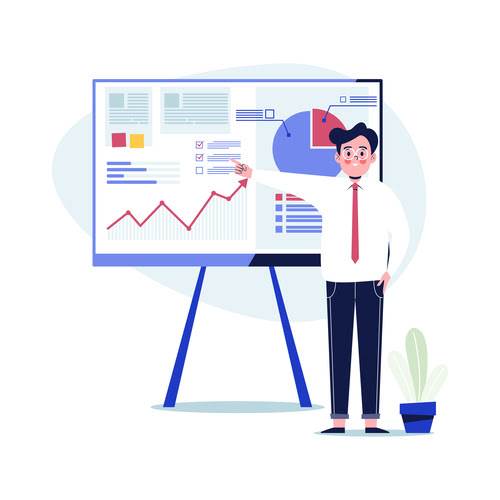Consumer demand is only rising for more information, services, products, and experiences to be readily available at arm’s length. Consumers aren’t the only ones who rely on mobile app development. Mobile apps also help companies create secure and scalable solutions for things like data collection, customer service, and automation. Mobile app development has seen extraordinary growth as a subsection of the vast tech industry. Whether a user is interested in finding love, testing a recipe, translating a phrase, or balancing their checkbook, there’s an app on their mobile device for that. Read on to learn more about the mobile app development industry and how you can get involved.

Connect your mobile application to powerful cloud services to add features and improve usability. Employ APIs to integrate new features, such as advanced cloud-based services that can help you enhance your mobile apps. These include push notifications, IBM Watson®-powered AI analytics, Internet of Things (IoT) smart device integration and more. Once you’ve selected the OS platform or platforms, you need to overcome the limitations of mobile devices and usher your app all the way past the potential hurdles of distribution. Fortunately, by following a few basic guidelines and best practices, you can streamline your application development journey.
What is Mobile Application Development?
The main advantage of React Native is its use of a single codebase to build mobile apps for different platforms and devices. Not only does it provide near-native mobile experiences, but it also accelerates mobile app development because developers need only write code once and then deploy it across multiple platforms. Believe it or not, Steve Jobs was originally against creating open-source development tools as he did not feel that Apple had the resources to properly police app developers. Instead, Jobs was of the opinion that mobile app development should live on the web. Ironically, a little more than a decade later, it’s becoming more clear that with the emergence of new technologies and trends, centralized control over app stores has, at times, stifled growth.
And the development cost doesn’t necessarily end once the app is built. The next stage is to plan how this will all fit together in your mobile app. Both Google and the Apple App Store make it easy for the development team to charge for the app. These are great for beginners as you just have to add the code to your app. The right one will depend on the type of mobile app you plan to release.
Best mobile app development software of 2023
Provide people with different tasks to do on your app and see if they are able to complete them. But if you’re just getting started and want to create a free app, you can do this using BuildFire’s app builder platform. This no-code software lets you build your own apps for free without writing a single line of code.
The first part of app development is coming up with a concept. Sounds simple enough, but bare-bones basics won’t do in this case; you have to fully flesh out your thoughts by asking the right questions as you go. You can even add a specific benefit for users who download the app and use it for the first time.
Step 6: Build your portfolio
Mobile UI contexts signal cues from user activity, such as location and scheduling that can be shown from user interactions within a mobile application. Overall, mobile UI design’s goal is primarily for an understandable, user-friendly interface. Data science has disrupted data analytics and mobile app development and pushed them to new heights that show promise both for businesses and consumers.

But the users who participate will become invested in the success of your app and give you genuine feedback. Your app analytics and KPIs need to go beyond app performance metrics, like speed and uptime (although both of these are obviously good to have in terms of performance and reliability). You could have the best app on the planet, but your efforts won’t matter if nobody knows about it. Your app must be marketed appropriately to get some eyeballs on it and pique user interest. If a customer discovers bugs, it’s going to create problems for your app’s long-term success. So don’t just test the app once on your phone and assume that it’s working correctly.
Microsoft Store
In the recent past there was only one way to build a mobile app which was by programming the smartphone using its platform’s native programming language. If you wanted to build an Apple/iOS app, you’d use Apple’s software development kit and if you wanted to build an Android app, you’d have to use Android’s native language. The University of California system’s flagship university in the Bay Area has an excellent extension school that offers programs all over the map. Its certificate program isn’t specific to mobile app development. However, it certainly offers plenty of coursework in the area.
- I was welcomed with eight offers, including $4 off a delivery order of $20 or more.
- The user responses will help you prioritize what features you need to work on next.
- Therefore, it’s improbable to think that web3 developers won’t be met with complications when it comes to pushing products in the general marketplace.
- The main differences between these options are the development cost, the time it takes to get set up, and the features you’ll have available.
The purpose of the wireframe is to simply illustrate the app’s features and layout the schemes. You can set goals related to the end-user, as well as goals related to your business. This in-depth guide reads best from start to finish, but feel free to click around to the sections that are most mobile app development relevant to your needs. Some of you might be starting from scratch, while others might be further along in the process. Decent performance, but dependent on the user’s browser and internet speed. We also talked with Alexey Pichukov[2], a software engineer at Raiffeisen Bank International AG.
ChatGPT app revenue shows no signs of slowing, but some other AI apps top it
Hence, it’s an excellent choice for developers seeking complete control over their code. Katalon’s intuitive interface, script customization options, and support for various testing scenarios make it an ideal tool for beginner and experienced testers. These include iPad/iPhone Mobile Application Development and its Android counterpart. There’s also a Multi-Platform Mobile App Development course to hone your skills on both platforms.

Technical skills include coding in one or several programming languages, learning to test and troubleshoot your app, and understanding user interface design. The mobile application development process is an end-to-end development schedule, involving the planning, strategy, development and testing of your app. It contains numerous stakeholders, including app owners, project managers, designers and developers and can last anywhere from weeks to several months or years.
TDWI Training & Research Business Intelligence, Analytics, Big Data, Data Warehousing
The cost of developing a mobile app can vary depending on factors like app type, functionality, complexity, selected vendor, and the development approach. However, the tentative cost is $40,000 to $150,000 and can exceed $300,000 in some cases. Overall, Postman can be a powerful tool for any software development team. It is also free for personal and commercial use, making it an affordable option for developers.
He has extensive experience in the MS stack, coding, and enhancing process delivery. Akash is a highly skilled and experienced technologist passionate about building high-quality software. Firebase Performance Monitoring is a service that helps you monitor the performance of your mobile apps. It collects data about your app’s CPU usage, memory usage, network traffic, and user sessions to identify performance bottlenecks and optimize your app’s performance. Developers may learn to work with one operating system and move on to the other as they progress in their careers. Being able to work with both operating systems would make you more competitive in the mobile app developer job market.
How to Become a Mobile App Developer (Beginner’s Guide to App Development)
An example of a back-end service for a mobile front-end could be a database that contains information used in the app. Learn what a no-code platform is and how it can be used to save businesses time and money while being able to deploy more apps at a faster rate. Once the app passes these tests, it’s time to roll it out to users for official beta testing. This process includes multiple rounds of review and incorporating user fixes prior to creating a deployable version of your app.

